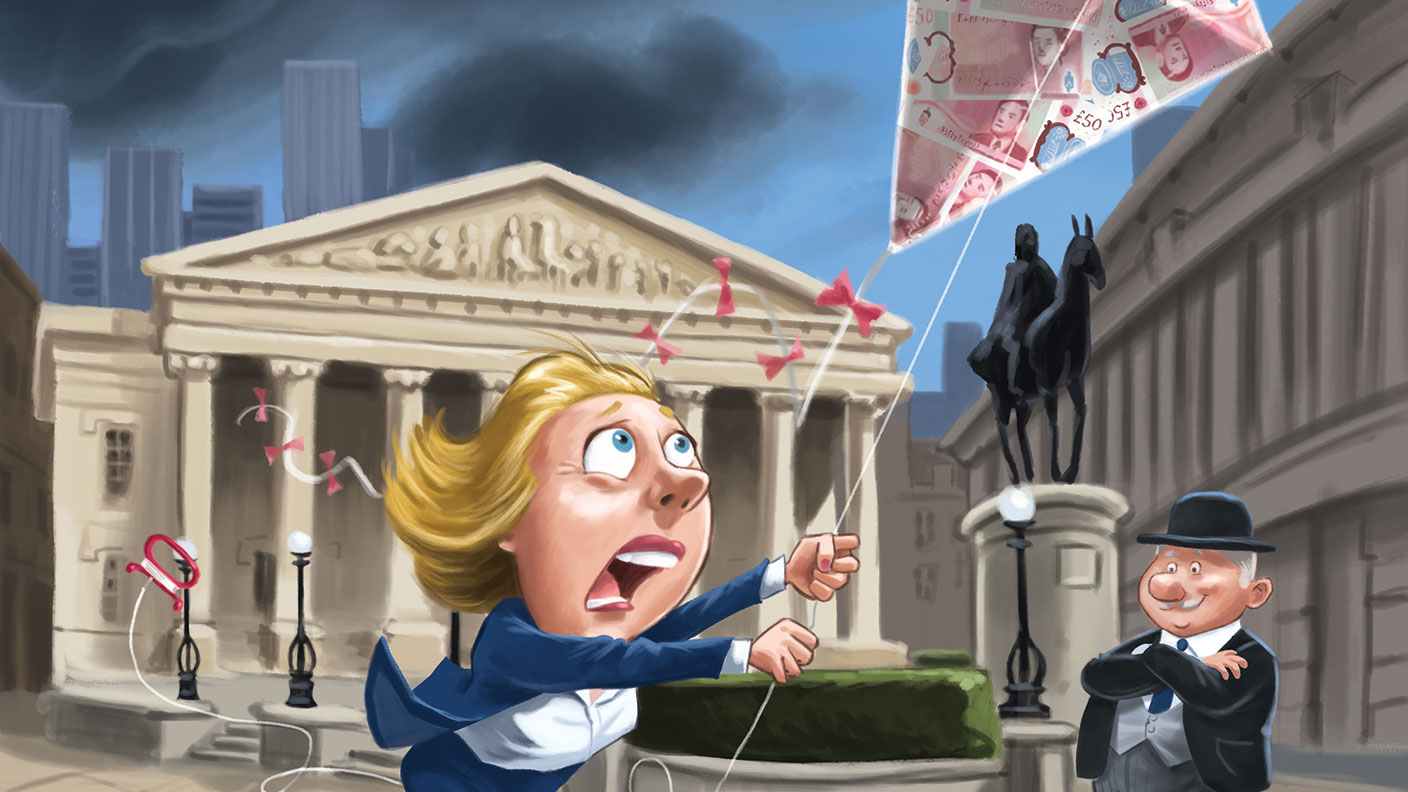How we saved capitalism – only to cripple it
Since 2008, central bankers have resorted to ever more extreme measures to save us from depression. The result is a banquet of serious consequences for investors, says Satyajit Das.

Since 2008, central bankers have resorted to ever more extreme measures to save us from depression. The result is a banquet of serious consequences for investors, says Satyajit Das.
Social progress has become synonymous with higher living standards. However, since the 1980s steady improvements in our living standards have been brought about largely by borrowing more.
Rising debt has helped to generate economic growth, by bringing forward spending that would normally have taken place over a period of years. Today, total borrowing by governments, households and non-financial corporations exceeds $160trn (around 230% of global GDP), triple the level of the early 1980s. Since 2008, total public and private debt in major economies has risen by more than $60trn, an increase of around 20 percentage points of GDP.
MoneyWeek
Subscribe to MoneyWeek today and get your first six magazine issues absolutely FREE

Sign up to Money Morning
Don't miss the latest investment and personal finances news, market analysis, plus money-saving tips with our free twice-daily newsletter
Don't miss the latest investment and personal finances news, market analysis, plus money-saving tips with our free twice-daily newsletter
Unfortunately, around 85% of the debt incurred in recent years has funded the purchase of existing assets or consumption, rather than being used for creating new businesses or productive purposes that build wealth. Consequently, total debt has grown at rates well above the corresponding rate of economic growth. This means that the credit intensity of the US economy has increased. Around $4-$5 of debt is needed today to generate each additional dollar of GDP, up from $1-$2 30 years ago.
This problem is compounded by the overhang of accrued entitlements for retirement income, old-age care and health care. If unfunded government obligations to deliver what has been promised were taken into account, US debt levels would more than double. If we measure national net wealth as the difference between the current value of cash inflows (future tax revenues) and cash outflows (expected budget deficits, debt and committed future expenditure such as defence, justice, education, social welfare, health and old-age care), the US and UK have a net worth of 800% and 500% of GDP respectively. They are not alone: many other nations are overstretched to the point where de-facto insolvency is plausible.
This economic model is unsustainable, yet that reality has been ignored through successive financial crises. After the global financial crisis in 2008, policymakers refused to acknowledge the fundamental problems, instead resorting to traditional instruments such as budget deficits, low interest rates and abundant liquidity to restore growth and inflation, with the aim of managing the large debt burden. Strong growth would increase the ability to service the debt and reduce its size relative to GDP. Inflation would boost nominal growth and reduce the purchasing power of outstanding debt. But these fiscal and monetary policies have proved ineffective. They have brought artificial stability but no sustainable recovery.
While private-sector demand remains weak, expansionary fiscal policy appears unable fully to offset the decline in growth. Government spending only provides a short-term lift; unless higher levels of spending continue, it cannot lead to increased ongoing economic activity. Public infrastructure investment can increase growth, but potential returns on the infrastructure projects chosen need to be sufficiently high to avoid capital becoming tied up in poorly performing assets. Meanwhile, persistent budget deficits exacerbate already high levels of public debt.
On the monetary-policy side, central banks have cut interest rates (more than 650 cuts globally since 2009) and embarked on quantitative-easing (QE) programmes that are intended to promote debt-financed expenditure and stimulate economic activity. But high existing debt levels and weak banking systems have constrained new borrowing. Meanwhile, a combination of low commodity prices (especially in energy), overcapacity in many industries, lack of pricing power and currency devaluations has kept inflation low.
These policies have toxic side effects. Low interest rates affect the viability of retirement savings arrangements. They create economic distortions, allowing zombie companies to survive through lower debt-service costs. They encourage substitution of labour with capital, reducing employment and hence consumption. And they lead to mispricing of risk, resulting in overvalued asset markets. Low interest rates are also used in policymakers' attempts to devalue their currencies to gain a competitive advantage in export markets. But retaliation by other countries limits the effectiveness of this approach. Instead, it results in destabilising short-term cross-border capital flows and a relentless spiral of lower interest rates, monetary expansion and deflationary pressures.
Exiting these fiscal and monetary policies is difficult. Austerity would result in an economic slowdown. Normalisation of interest rates would make high levels of borrowing unmanageable. Ending QE and hence withdrawing central-bank liquidity would affect asset prices and reduce demand for bonds and many equities. A large price correction in asset markets would reduce the value of the collateral that supports bank lending, setting off a fresh financial crisis. Hence the global economy may be trapped in a QE-forever cycle, where each bout of economic weakness forces policymakers to implement yet more expansionary fiscal measures and QE. Throughout this, debt levels continueto increase, making the position more intractable.
Can we grow our way out of this mess?
The fundamental problem for the world is that real growth is driven by population growth, the development of new markets, increased productivity and technological innovation, not by financial sleight of hand. None of these factors is likely to come to our rescue in the near future. In the 20th century the world's population doubled twice. In the 21st century it will not even double once. Worse, most population growth is in poorer countries that do not contribute to growth. There are few nations left to integrate into the global trading system to add new markets, while improvements in productivity have slowed.
Mankind continues its romance with technology, ignoring the fact that urgent problems such as climate change can be traced to inventions such as internal combustion engines, electricity and exploitation of fossil fuels.
Unfortunately, current innovation does not entail a radical reshaping of industry, but small improvements to existing processes to expand usage or increase efficiency. Smart phones and connectivity feed cheap narcissism, entertainment and shopping. Innovations such as robotics and artificial intelligence reduce living standards as they replace or deskill most workers. Innovation now enriches a few people who control or finance the technology at the expense of the vast majority of the population. This entrenches and increases inequality. Meanwhile, we face increasing resource constraints, especially water, food and energy, as well as environmental stresses. These are compounded by worsening demographics, inequality and exclusion.
A prolonged period of stagnation is the likely outcome. Economic growth remains weak and volatile. There is disinflation or deflation. Debt levels remain high or are on the rise. Competition for growth and markets drives beggar-thy-neighbour policies, resulting in slowdowns in trade and capital movements. These chronic problems require constant intervention in the form of fiscal stimulus and accommodative monetary policy, low rates and periodic QE programmes to avoid deterioration. Financial repression becomes implicit policy in other words, official rates are held below the true inflation rate, which wipes out savers and allows over-indebted borrowers to deleverage. If deflation emerges, then negative interest rates engineer an explicit reduction in the nominal face value of debt.
The trajectory is evident in proposals to eliminate physical cash, ostensibly to prevent tax avoidance, crime and terrorism, as well as improve efficiency and lower costs. The real reason is that governments will need to cut already-low interest rates deep into negative territory. Eliminating physical money is necessary to prevent people escaping this by shifting their savings into banknotes and putting them under the bed.
It is not clear whether the authorities can maintain this uneasy equilibrium for a prolonged period. Policy errors or miscalculation may cause a complete loss of credibility or confidence in policymakers' ability to control the situation. With policies now possessing the potency of rain dances, finance officials are turning to increasingly desperate measures, such as increased government spending directly financed by central banks creating new money.
The response of electorates to the reduction of living standards and destruction of savings by stealth is unpredictable. It is worrying to recall that in the Great Depression the destruction of the wealth of the middle classes was an important factor in the rise of extremism. Ultimately, the refusal to accept the high short-term costs of a major reset of the system in 2008 has created the conditions for a new crisis. Unwinding of the unsustainable excesses will be more difficult than in 2008. Problems, such as debt levels, are larger, while policymakers' capacity to respond is limited. These problems will be accentuated by political stresses and the deteriorating geopolitical situation.
Developed countries, in particular, are now trapped. They cannot accept the pain of debt reduction. They will not accept any reduction of living standards. They must rely on fanciful financial engineering to maintain the illusion of stability. The world is remarkably complacent about the risks. Everyone hopes that "something" will restore the global economy to the exemplary growth rates of the last 30 years and its associated rises in living standards, wealth and opportunity. But as Sigmund Freud observed: "Illusions commend themselves to us because they save us pain We must therefore accept it without complaint when they sometimes collide with a bit of reality against which they are dashed to pieces."
Satyajit Das is a former banker. This article is based on his latest book, A Banquet of Consequences. He is also the author of Extreme Money and Traders, Guns & Money.
What low rates and slow growth mean for your investments
Savings are invested with three simple objectives: capital security; income generation or cash flow; and price appreciation. Depending on the economic environment, the specific order of priority changes. After 2008, the purchase of long-duration, fixed-income instruments bonds maturing far in the future yielded substantial returns. However, falling interest rates and long-term yields now mean that it is far harder to secure reasonable income streams. Government debt no longer offers "risk-free" return, but only return-free risk. Investors have been forced to purchase securities maturing further in the future or take on more credit risk.
High-dividend shares and rental property are increasingly treated as substitutes for bonds. But equity payouts and rental yields may not be sustainable in an environment of low growth and deflation. In addition, equity valuations are stretched by mergers and acquisitions mania and by share buybacks. And the prices of all risk assets, including real estate, are supported by low rates, abundant liquidity and QE. Hence many investments today are examples of what economist John Kenneth Galbraith termed "the bezzle": theft where there is a lengthy gap between a crime and its discovery. They offer the prospect of high returns, but this may not compensate for the real risk that only emerges much later. Investors believe that their investments are sound and continue to feel wealthy, like the victim of an undiscovered robbery who continues to feel rich because he does yet not know of his loss.
Capital gains on equities and property that exist on paper must be converted into cash to provide purchasing power. Many investments are not capable of being sold at their current market value. Realising real-estate profits requires the property to be sold (or the investor to borrow against the value of the property). This will depend on the availability of future purchasers who have high-enough incomes to support the ever-increasing level of borrowing required to afford inflated property prices. Demand for property is also affected by demographics as well as labour market changes, including reduction in secure long-term employment, rise in contracting and self-employment and stagnant incomes.
Meanwhile, equity markets will be affected by changing investment flows. Rising wealth created strong markets for equities in the post-war era, in part supported by forced or tax-incentivised pension savings. But as ageing populations draw down their savings, withdrawals may be greater than new inflows, reducing demand for equities.
Unless you are a best-of-all-time trader who can adroitly trade the volatility of frequent policy-driven melt-ups and melt-downs, investors will need to adjust downwards their expectations for returns and to switch their focus from capital gains and high income to security from return on capital to return of capital. That means focusing on hard-to-find, higher-quality assets, such as cash or short-term government bonds, rather than reaching for higher returns in more speculative assets.
Prudent investors must be willing to accept the low returns available and not be seduced by riskier assets that promise higher returns, unlikely to be realised. They are likely to find themselves in a minority, for, as Samuel Lloyd, an English financier, observed: "No warning can save a people determined to grow suddenly rich."
Get the latest financial news, insights and expert analysis from our award-winning MoneyWeek team, to help you understand what really matters when it comes to your finances.
Satyajit Das is a former banker and author. His books include A Banquet of Consequences, Extreme Money and Traders, Guns & Money.
-
 ISS backs Edinburgh Worldwide’s board as Saba questions SpaceX selloff
ISS backs Edinburgh Worldwide’s board as Saba questions SpaceX selloffShareholder advisor ISS has recommended that shareholders vote against Saba’s proposals to replace the board of the Baillie Gifford-managed investment trust
-
 13 tax changes in 2026 – which taxes are going up?
13 tax changes in 2026 – which taxes are going up?As 2026 gets underway, we look at what lies ahead in terms of changes to tax rates and allowances this year and how it will affect you.
-
 Governments will sink in a world drowning in debt
Governments will sink in a world drowning in debtCover Story Rising interest rates and soaring inflation will leave many governments with unsustainable debts. Get set for a wave of sovereign defaults, says Jonathan Compton.
-
 Why Australia’s luck is set to run out
Why Australia’s luck is set to run outCover Story A low-quality election campaign in Australia has produced a government with no clear strategy. That’s bad news in an increasingly difficult geopolitical environment, says Philip Pilkington
-
 Why new technology is the future of the construction industry
Why new technology is the future of the construction industryCover Story The construction industry faces many challenges. New technologies from augmented reality and digitisation to exoskeletons and robotics can help solve them. Matthew Partridge reports.
-
 UBI which was once unthinkable is being rolled out around the world. What's going on?
UBI which was once unthinkable is being rolled out around the world. What's going on?Cover Story Universal basic income, the idea that everyone should be paid a liveable income by the state, no strings attached, was once for the birds. Now it seems it’s on the brink of being rolled out, says Stuart Watkins.
-
 Inflation is here to stay: it’s time to protect your portfolio
Inflation is here to stay: it’s time to protect your portfolioCover Story Unlike in 2008, widespread money printing and government spending are pushing up prices. Central banks can’t raise interest rates because the world can’t afford it, says John Stepek. Here’s what happens next
-
 Will Biden’s stimulus package fuel global inflation – and how can you protect your wealth?
Will Biden’s stimulus package fuel global inflation – and how can you protect your wealth?Cover Story Joe Biden’s latest stimulus package threatens to fuel inflation around the globe. What should investors do?
-
 What the race for the White House means for your money
What the race for the White House means for your moneyCover Story American voters are about to decide whether Donald Trump or Joe Biden will take the oath of office on 20 January. Matthew Partridge explains how various election scenarios could affect your portfolio.
-
 What’s worse: monopoly power or government intervention?
What’s worse: monopoly power or government intervention?Cover Story Politicians of all stripes increasingly agree with Karl Marx on one point – that monopolies are an inevitable consequence of free-market capitalism, and must be broken up. Are they right? Stuart Watkins isn’t so sure.